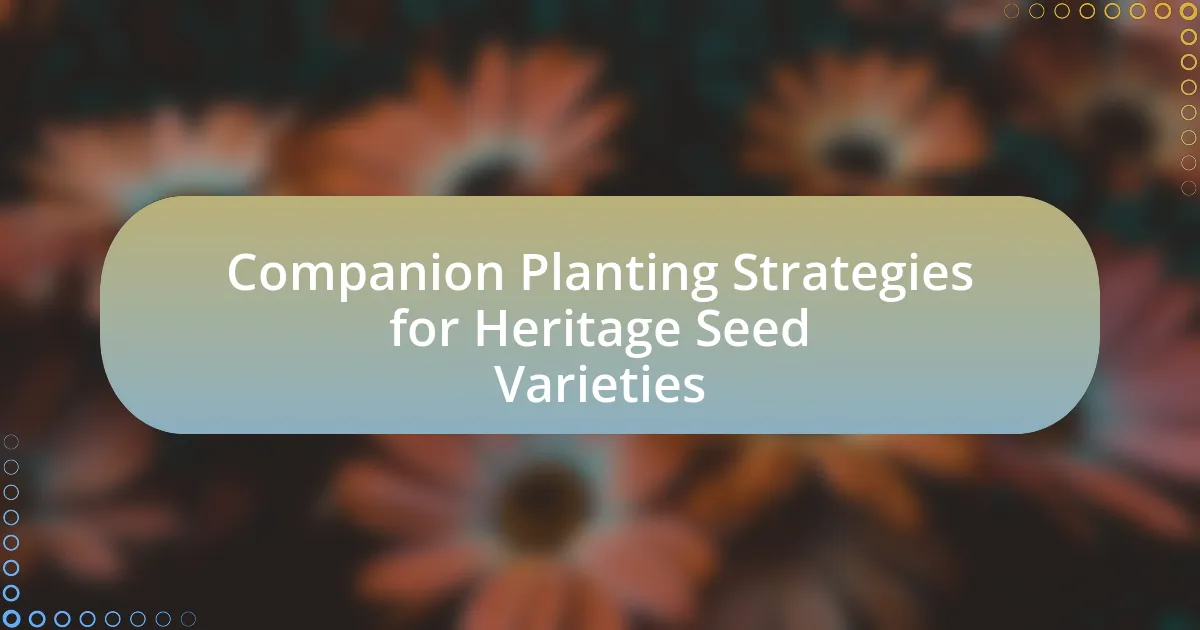The article focuses on essential soil preparation tips for planting heritage seeds, emphasizing the importance of soil testing, organic matter amendment, tilling, and drainage. It outlines how soil quality affects seed growth, detailing key characteristics such as pH, nutrient content, and texture that should be assessed for optimal conditions. Additionally, the article discusses the role of organic matter, the benefits of cover crops, and the impact of soil structure on seed germination. Practical tips for effective soil preparation scheduling and resources for further guidance are also provided, ensuring a comprehensive understanding of best practices for cultivating heritage seeds.

What are the essential steps for soil preparation before planting heritage seeds?
The essential steps for soil preparation before planting heritage seeds include testing the soil, amending it with organic matter, tilling, and ensuring proper drainage. Testing the soil determines its pH and nutrient levels, which informs necessary amendments. Amending the soil with organic matter, such as compost, enhances fertility and structure, promoting healthy seed growth. Tilling the soil loosens it, allowing for better root penetration and aeration. Finally, ensuring proper drainage prevents waterlogging, which can harm seed germination and growth. These steps collectively create an optimal environment for heritage seeds to thrive.
How does soil quality impact the growth of heritage seeds?
Soil quality significantly impacts the growth of heritage seeds by influencing nutrient availability, water retention, and microbial activity. High-quality soil, characterized by optimal pH levels, organic matter content, and good structure, provides essential nutrients that heritage seeds require for germination and growth. For instance, research indicates that soils rich in organic matter can enhance nutrient cycling and improve soil structure, leading to better root development and increased resilience against pests and diseases. Additionally, studies show that well-aerated and well-drained soils promote healthy microbial communities, which are crucial for breaking down organic matter and facilitating nutrient uptake by plants.
What soil characteristics should be assessed for optimal seed growth?
Optimal seed growth requires assessment of soil characteristics such as pH, nutrient content, texture, drainage, and organic matter. Soil pH affects nutrient availability; for most seeds, a pH between 6.0 and 7.5 is ideal. Nutrient content, including nitrogen, phosphorus, and potassium levels, is crucial for seedling development, as these macronutrients support growth and health. Soil texture influences water retention and aeration; loamy soils are generally best for seed growth due to their balanced composition. Proper drainage prevents waterlogging, which can harm seeds, while adequate organic matter enhances soil fertility and structure, promoting healthy root development. These characteristics collectively create an optimal environment for seed germination and growth.
How can soil pH affect heritage seed germination?
Soil pH significantly affects heritage seed germination by influencing nutrient availability and seedling health. A pH level that is too low (acidic) or too high (alkaline) can hinder the absorption of essential nutrients, such as nitrogen, phosphorus, and potassium, which are critical for seed development. Research indicates that most heritage seeds thrive in a pH range of 6.0 to 7.5, where nutrient availability is optimal. For instance, a study published in the Journal of Plant Nutrition found that seeds germinated in soil with a pH of 6.5 exhibited higher germination rates and stronger seedling vigor compared to those in more extreme pH conditions. Thus, maintaining an appropriate soil pH is crucial for successful germination of heritage seeds.
Why is soil structure important for planting heritage seeds?
Soil structure is crucial for planting heritage seeds because it directly influences root development, water retention, and nutrient availability. A well-structured soil allows for adequate aeration and drainage, which are essential for healthy seed germination and growth. Research indicates that soils with good structure, characterized by stable aggregates, enhance microbial activity and organic matter retention, both of which are vital for the success of heritage seeds. For instance, studies show that heritage varieties often thrive in loamy soils with a balanced mix of sand, silt, and clay, which supports optimal moisture levels and nutrient exchange.
What types of soil structures are best for heritage seeds?
Loamy soil structures are best for heritage seeds. Loamy soil, which is a balanced mixture of sand, silt, and clay, provides excellent drainage, aeration, and nutrient retention, making it ideal for the growth of diverse seed varieties. Research indicates that heritage seeds thrive in environments where soil structure supports microbial activity and organic matter, both of which are abundant in loamy soils. This type of soil structure enhances seed germination and plant health, ensuring robust growth and yield.
How can soil compaction be alleviated before planting?
Soil compaction can be alleviated before planting by incorporating organic matter, such as compost or well-rotted manure, into the soil. This practice improves soil structure, increases porosity, and enhances water infiltration, which are essential for healthy root development. Research indicates that adding organic matter can reduce bulk density and improve soil aeration, making it easier for plant roots to penetrate the soil. For example, a study published in the “Soil Science Society of America Journal” found that soils amended with organic matter showed a significant decrease in compaction levels, leading to better plant growth outcomes.
What role does organic matter play in soil preparation?
Organic matter is crucial in soil preparation as it enhances soil structure, fertility, and moisture retention. By improving soil aggregation, organic matter facilitates better aeration and root penetration, which are essential for healthy plant growth. Additionally, it provides a source of nutrients through decomposition, enriching the soil with essential elements like nitrogen, phosphorus, and potassium. Studies have shown that soils rich in organic matter can increase crop yields by up to 20%, demonstrating its significant role in sustainable agriculture and effective soil management.
How can compost improve soil health for heritage seeds?
Compost improves soil health for heritage seeds by enhancing nutrient availability, soil structure, and microbial activity. The organic matter in compost provides essential nutrients such as nitrogen, phosphorus, and potassium, which are crucial for the growth of heritage seeds. Additionally, compost improves soil structure by increasing aeration and water retention, creating an optimal environment for seed germination and root development. Research indicates that compost application can increase soil microbial diversity, which supports plant health by promoting beneficial interactions and disease resistance. Studies have shown that soils enriched with compost exhibit higher levels of beneficial microorganisms, leading to improved plant vigor and yield.
What are the benefits of using cover crops in soil preparation?
Using cover crops in soil preparation enhances soil health and fertility. Cover crops prevent soil erosion, improve soil structure, and increase organic matter content, which leads to better water retention and nutrient availability. Research indicates that cover crops can reduce the need for chemical fertilizers by fixing nitrogen in the soil, as demonstrated in studies showing a 30% reduction in nitrogen fertilizer use when cover crops are employed. Additionally, they suppress weeds and pests, contributing to a more sustainable farming practice.
How can soil testing enhance the preparation process?
Soil testing enhances the preparation process by providing precise information about nutrient levels, pH, and soil composition. This data allows farmers and gardeners to tailor their soil amendments and fertilizers to meet the specific needs of heritage seeds, ensuring optimal growth conditions. For instance, a study published in the Journal of Soil Science found that soil testing can increase crop yields by up to 20% when appropriate amendments are applied based on test results. By identifying deficiencies or imbalances, soil testing helps in creating a balanced environment that supports the unique requirements of heritage seeds, ultimately leading to healthier plants and better harvests.
What specific nutrients should be tested for when preparing soil for heritage seeds?
When preparing soil for heritage seeds, specific nutrients that should be tested include nitrogen, phosphorus, potassium, calcium, magnesium, and sulfur. These nutrients are essential for optimal plant growth and development. Nitrogen supports leaf and stem growth, phosphorus is crucial for root development and flowering, while potassium enhances overall plant health and disease resistance. Calcium and magnesium contribute to cell wall structure and enzyme function, and sulfur is important for protein synthesis. Testing for these nutrients ensures that the soil provides a balanced environment for heritage seeds, promoting successful germination and growth.
How often should soil tests be conducted for optimal results?
Soil tests should be conducted every 2 to 3 years for optimal results. Regular testing helps monitor nutrient levels and pH balance, which are crucial for the health of heritage seeds. Research indicates that soil composition can change over time due to factors like crop rotation and organic matter decomposition, making periodic assessments essential for effective soil management.

What techniques can be used to prepare soil for planting heritage seeds?
To prepare soil for planting heritage seeds, techniques such as soil testing, organic matter incorporation, and proper tillage should be employed. Soil testing identifies nutrient levels and pH, ensuring the soil meets the specific needs of heritage seeds. Incorporating organic matter, like compost or well-rotted manure, enhances soil fertility and structure, promoting healthy seed growth. Proper tillage, which involves loosening the soil without overworking it, improves aeration and drainage, creating an optimal environment for seed germination. These methods are supported by agricultural studies indicating that well-prepared soil significantly increases seed viability and crop yield.
How can tilling affect soil preparation for heritage seeds?
Tilling can significantly enhance soil preparation for heritage seeds by improving soil aeration, structure, and nutrient availability. When soil is tilled, it breaks up compacted layers, allowing roots to penetrate more easily and access water and nutrients. Additionally, tilling incorporates organic matter into the soil, which can improve fertility and microbial activity, both crucial for the growth of heritage seeds. Research indicates that well-aerated soil promotes healthier root systems, leading to better crop yields. Therefore, proper tilling practices can create an optimal environment for heritage seeds to thrive.
What are the pros and cons of different tilling methods?
Different tilling methods have distinct pros and cons that affect soil health and crop yield. Conventional tilling, which involves turning over the soil, can improve seedbed preparation and weed control but may lead to soil erosion and loss of organic matter. Reduced tillage minimizes soil disturbance, enhancing moisture retention and soil structure, yet it may require more herbicide use to manage weeds. No-till farming preserves soil integrity and promotes biodiversity but can initially result in lower yields and requires specialized equipment. Each method’s effectiveness varies based on soil type, climate, and crop selection, making it essential for farmers to choose the appropriate tilling method for their specific conditions.
How deep should soil be tilled for heritage seed planting?
Soil should be tilled to a depth of 6 to 12 inches for heritage seed planting. This depth allows for adequate aeration, root development, and nutrient availability, which are essential for the successful growth of heritage plants. Research indicates that tilling within this range promotes optimal soil structure and enhances moisture retention, both critical factors for seed germination and plant health.
What are the best practices for amending soil before planting?
The best practices for amending soil before planting include testing the soil, adding organic matter, adjusting pH levels, and incorporating nutrients. Testing the soil provides essential information about nutrient levels and pH, which guides the amendment process. Adding organic matter, such as compost or well-rotted manure, improves soil structure, enhances moisture retention, and increases microbial activity. Adjusting pH levels ensures that the soil is within the optimal range for plant growth, typically between 6.0 and 7.0 for most crops. Incorporating specific nutrients, such as nitrogen, phosphorus, and potassium, based on soil test results, supports healthy plant development. These practices are supported by research indicating that well-amended soil leads to improved crop yields and healthier plants.
How can fertilizers be effectively used in soil preparation?
Fertilizers can be effectively used in soil preparation by conducting a soil test to determine nutrient deficiencies and then applying the appropriate type and amount of fertilizer based on the test results. This targeted approach ensures that the soil has the necessary nutrients, such as nitrogen, phosphorus, and potassium, which are essential for healthy plant growth. Research indicates that using fertilizers in alignment with soil nutrient needs can enhance crop yields significantly; for instance, a study published in the “Journal of Agricultural Science” found that tailored fertilizer applications increased yields by up to 30% in certain crops.
What natural amendments can enhance soil fertility for heritage seeds?
Natural amendments that can enhance soil fertility for heritage seeds include compost, manure, bone meal, and green manure. Compost enriches the soil with organic matter and nutrients, improving soil structure and moisture retention. Manure provides essential nutrients like nitrogen, phosphorus, and potassium, which are vital for seed growth. Bone meal is a rich source of phosphorus, promoting strong root development and flowering. Green manure, such as clover or vetch, can be grown and then tilled back into the soil, adding organic matter and nutrients while improving soil health. These amendments have been shown to increase soil fertility and support the growth of heritage seeds effectively.
How can mulching contribute to soil preparation?
Mulching contributes to soil preparation by enhancing soil structure, moisture retention, and nutrient availability. When organic materials such as straw, wood chips, or grass clippings are applied to the soil surface, they decompose over time, improving soil aeration and promoting beneficial microbial activity. Research indicates that mulching can reduce soil temperature fluctuations, which is crucial for seed germination and root development. Additionally, a study published in the Journal of Soil and Water Conservation found that mulched soils retained 30% more moisture compared to bare soils, thereby supporting healthier plant growth.
What types of mulch are most beneficial for heritage seed planting?
Organic mulches, such as straw, wood chips, and shredded leaves, are most beneficial for heritage seed planting. These types of mulch improve soil structure, retain moisture, suppress weeds, and enhance soil fertility as they decompose. For instance, straw mulch can provide a protective layer that maintains soil temperature and moisture levels, which is crucial for the germination of heritage seeds. Additionally, wood chips break down slowly, offering long-term benefits by enriching the soil over time. Research indicates that organic mulches can increase soil microbial activity, which is essential for the health of heritage seed varieties.
How does mulching help retain soil moisture and temperature?
Mulching helps retain soil moisture and temperature by creating a protective layer over the soil that reduces evaporation and insulates the soil. This layer minimizes direct sunlight exposure, which lowers soil temperature during hot weather and helps maintain a more stable environment for plant roots. Research indicates that mulched soils can retain moisture levels up to 50% higher than unmulched soils, significantly benefiting plant health and growth.

What common mistakes should be avoided in soil preparation for heritage seeds?
Common mistakes to avoid in soil preparation for heritage seeds include neglecting soil testing, failing to amend the soil appropriately, and not ensuring proper drainage. Soil testing is crucial because it reveals nutrient levels and pH, which directly affect seed germination and plant health. Amending the soil with organic matter, such as compost, enhances fertility and structure, which is often overlooked. Additionally, ensuring proper drainage prevents waterlogging, which can harm heritage seeds that may be more sensitive to excess moisture. These practices are essential for successful cultivation and maximizing the potential of heritage seeds.
What are the pitfalls of over-fertilizing soil before planting?
Over-fertilizing soil before planting can lead to nutrient imbalances, which harm plant growth. Excessive fertilizer can cause salt buildup in the soil, leading to root burn and reduced water absorption. Additionally, over-fertilization can promote excessive foliage growth at the expense of fruit or flower production, ultimately affecting yield. Research indicates that high nitrogen levels can lead to increased susceptibility to pests and diseases, as plants become more lush and attractive to harmful organisms. Furthermore, nutrient runoff from over-fertilized soil can contaminate local waterways, contributing to environmental issues such as algal blooms.
How can excessive tilling harm soil health?
Excessive tilling can harm soil health by disrupting soil structure and depleting organic matter. When soil is tilled too frequently, it leads to compaction, which reduces aeration and water infiltration, negatively affecting root growth and microbial activity. Additionally, studies indicate that over-tilling can result in a significant loss of soil organic carbon, which is crucial for maintaining soil fertility and supporting plant growth. For instance, research published in the journal “Soil and Tillage Research” shows that continuous tillage can decrease soil organic matter by up to 50% over time, leading to diminished soil health and productivity.
What should be considered when timing soil preparation?
When timing soil preparation, it is essential to consider the local climate, soil temperature, and moisture levels. The local climate influences the optimal planting window; for instance, soil should be prepared when temperatures reach at least 50°F (10°C) for most crops. Soil temperature affects seed germination rates, as many seeds require specific temperatures to sprout effectively. Additionally, moisture levels are crucial; soil should not be overly wet or dry, as this can hinder proper tilling and nutrient incorporation. Research indicates that preparing soil too early can lead to erosion and nutrient loss, while waiting too long may result in missed planting opportunities.
How does seasonal timing affect soil readiness for planting heritage seeds?
Seasonal timing significantly affects soil readiness for planting heritage seeds by determining soil temperature, moisture levels, and nutrient availability. For instance, heritage seeds typically require soil temperatures between 60°F and 75°F for optimal germination, which aligns with spring planting in temperate climates. Additionally, soil moisture is crucial; planting too early in the season can lead to waterlogged conditions, while late planting may result in insufficient moisture. Research indicates that soil nutrient levels fluctuate with seasonal changes, impacting seedling vigor and growth. Therefore, aligning planting schedules with seasonal conditions ensures that heritage seeds have the best chance for successful establishment and growth.
What practical tips can ensure successful soil preparation for heritage seeds?
To ensure successful soil preparation for heritage seeds, start by testing the soil pH and nutrient levels, aiming for a pH between 6.0 and 7.0, which is optimal for most heritage varieties. This can be achieved through soil testing kits available at garden centers or agricultural extensions. Following the test, amend the soil with organic matter such as compost or well-rotted manure to enhance fertility and structure. Incorporating these amendments improves soil aeration and water retention, which are crucial for seed germination and root development. Additionally, till the soil to a depth of at least 12 inches to break up compaction and promote healthy root growth. Regularly rotating crops and practicing cover cropping can also maintain soil health and prevent nutrient depletion, ensuring a robust environment for heritage seeds.
How can gardeners effectively plan their soil preparation schedule?
Gardeners can effectively plan their soil preparation schedule by assessing soil health, determining the optimal planting time, and incorporating necessary amendments. First, conducting a soil test helps identify nutrient levels and pH, guiding the selection of appropriate amendments such as compost or fertilizers. Next, gardeners should consider the specific planting dates for heritage seeds, which often require specific soil temperatures and conditions. For instance, many heritage seeds thrive when soil temperatures reach 60°F to 70°F. Additionally, scheduling soil preparation activities, such as tilling and adding organic matter, at least two to four weeks before planting ensures that the soil is adequately prepared. This timeline allows for the breakdown of amendments and improves soil structure, promoting better seed germination and plant growth.
What resources are available for further guidance on soil preparation techniques?
Resources available for further guidance on soil preparation techniques include agricultural extension services, university agricultural departments, and online platforms such as the USDA’s Natural Resources Conservation Service. Agricultural extension services provide localized advice and workshops on soil management, while university departments often publish research and guidelines on best practices for soil preparation. The USDA’s Natural Resources Conservation Service offers comprehensive resources, including soil health assessments and preparation techniques tailored for various crops, including heritage seeds. These resources are validated by extensive research and practical applications in the field of agriculture.





